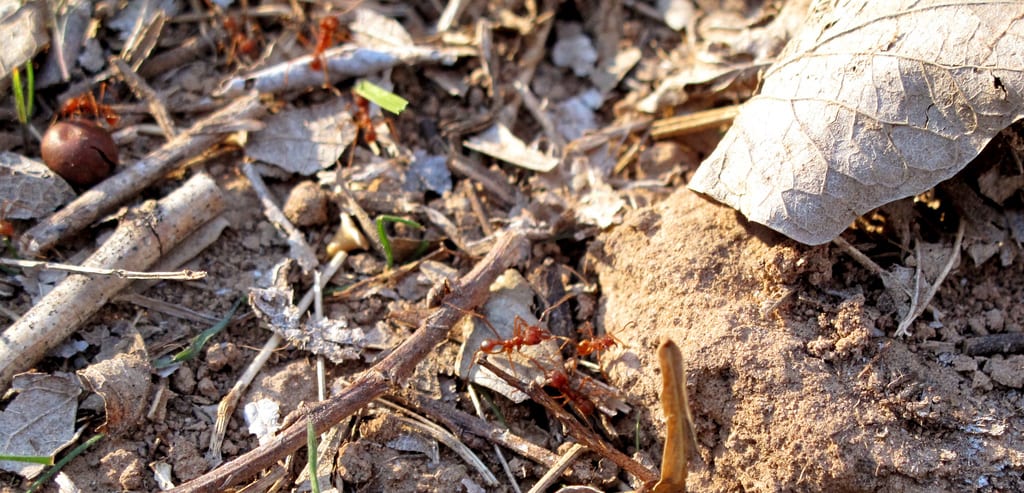by Suzie Henderson, Athens Science Café
What is an ecosystem engineer?
Every ecosystem, even arctic ice [2], is subject to the influence of ecosystem engineers [3]. An ecosystem engineer alters habitat and consequently changes resource availability to other organisms [2]. Even though all organisms play a role in resource cycling to varying degrees, not all are ecosystem engineers. The dilemma in defining an ecosystem engineer is that it's just too simple. There is no list of unifying features for ecosystem engineers, although many play similar roles (e.g. plants or burrowing animals) [2]. There are many types of ecosystem engineers (plants, animals, fungi, or microorganisms) and even invasive species are having huge impacts on the habitats of native species. To clear things up a bit, let me give you an example of a small, but mighty ecosystem engineer that also happens to be a superorganism.
Ant-scaled Engineering
Take tropical leaf-cutter ant species Atta cephalotes, for example. These tiny, unassuming invertebrates are classified as ecosystem engineers for their surprisingly significant influence on resource distribution in tropical forest ecosystems [5]. These tiny herbivores with big appetites gather foliage, flower parts, and seeds from vegetation along their foraging paths and are capable of consuming 15% of standing leaf crop [5]. Just picture it– oh look, a picture!

Millions of ants haul disproportionately large plant fragments back to their massive nests (average of 23 cubic meters in volume [4]) to subterranean chambers. Their forage is not their food, but serves as substrate for fungus cultivation. This unique “farming†process provides the ants' sole nutrition source and also increases the nutrient content of the soil by increasing its organic content [4]. They were vegetarians and agriculturists before it was cool.
So how does their engineering affect other organisms? Plants with deep roots tap into the nutrient hotspots near nests [1,6]. In addition, leaf-cutters remove foliage and sometimes cause tree mortality, creating small gaps that open up space and promote changes in resource availability, such as light [1]. By their herbivory, leaf-cutter ants indirectly impact the soil conditions of their nests in addition to nest engineering. Plants, which are ecosystem engineers themselves, control light availability by casting shade, which in turn regulates soil temperature and moisture. Below ground, their roots impact the structure and porosity of the soil.
Human-scaled Engineering
Though touted as ecosystem engineers “par excellence [2],†we humans have a humbling lesson to learn from our fellow members of the animal kingdom: don't underestimate the little guys. Nevertheless, no ecosystem engineering species can equal the impact of human beings. From deforestation in the tropics to destructive mining, we definitely have made our mark. Perhaps we can be viewed as superorganisms on steroids.
As a final note, ecosystem engineering impacts are not only negative. Just look back at the beaver example- by damming a stream, although many terrestrial organisms may be washed out, the pond will serve as habitat for a myriad of microorganisms, amphibians, turtles, and waterfowl. Even so, there are still losers, such as those organisms who rely on faster-moving water. Back to humans- we don't simply destroy everything in our path. We also create habitats that can be beneficial to other organisms, such as native plant gardens or artificial wetlands. One could even argue that without ecosystem engineers, the world would not be quite as interesting, or well, different.
About the Author
 Suzie Henderson is an undergraduate student in the Odum School of Ecology at the University of Georgia where she helps tend to the Chew Crew. She enjoys learning, gardening, cooking, and her family and friends. Connect with her on Facebook or email her at suzieuga@uga.edu. Suzie Henderson is an undergraduate student in the Odum School of Ecology at the University of Georgia where she helps tend to the Chew Crew. She enjoys learning, gardening, cooking, and her family and friends. Connect with her on Facebook or email her at suzieuga@uga.edu. |
References
- Farji-Brener, A.G. & A.E. Illes 2000. Do leaf-cutting ant nests make “bottom-up†gaps in neotropical rainforests?: a critical review of the evidence. Ecology Letters 3:219-227.
- Jones, C.G., J.H. Lawton, and M. Shachak. 1997. Positive and negative effects of organisms as physical ecosystem engineers. Ecological Society of America 78:1946-1957.
- Jones, C.G., J.H. Lawton, and M. Shachak. 1994. Organisms as ecosystem engineers. Oikos 69:373-386
- Meyer, S.T., M. Neubauer, E.J. Sayer, I.R. Leal, M. Tabarelli, and R. Wirth. 2013. Leaf-cutting ants as ecosystem engineers: topsoil and litter perturbations around Atta cephalotes nests reduce nutrient availability. Ecological Entymology 38(5):497-504.
- Meyer, S.T., I.R. Leal, M. Tabarelli, and R. Wirth. 2011. Ecosystem engineering by leaf-cutting ants: nests of A. cephalotes drastically alter forest structure and microclimate. Ecological Entymology 36:14-24.
- Saha, A.K., K.S. Carvalho, L.S.L. Sternberg, and P. Moutinho. 2012. Effect of leaf-cutting nests on plant growth in an oligotrophic Amazon rain forest. Journal of Tropical Ecology 28:263-270.
- http://www.csmonitor.com/Environment/2012/0607/Beneath-Arctic-ice-scientists-find-an-ecosystem-never-imagined-video
- http://www.theecologist.org/blogs_and_comments/Blogs/2525339/confronting_the_threat_of_invasive_ecosystem_engineers.html
- http://www.livescience.com/8020-insect-colonies-function-superorganisms.html
- http://www.alexanderwild.com/Ants/Taxonomic-List-of-Ant-Genera/Atta/
- http://ecology.info/ecosystem-engineers.htm
- http://www.ecology.info/beaver-ecology.htm
- http://earthobservatory.nasa.gov/Features/Deforestation/
- http://www.tnhistoryforkids.org/places/ducktown_basin
- http://nativeplantwildlifegarden.com/how-to-design-your-native-plant-wildlife-garden/
- http://www.hydratelife.org/?p=227
About the Author
- athenssciencecafehttps://athensscienceobserver.com/author/athenssciencecafe/April 17, 2020
- athenssciencecafehttps://athensscienceobserver.com/author/athenssciencecafe/April 12, 2020
- athenssciencecafehttps://athensscienceobserver.com/author/athenssciencecafe/April 3, 2020
- athenssciencecafehttps://athensscienceobserver.com/author/athenssciencecafe/March 30, 2020







